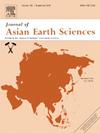Age, kinematics, and magnitude of the last surface rupturing event along the central Pambak-Sevan-Syunik fault (Armenia): Probable implications for landslides and lake tsunamis
IF 2.7
3区 地球科学
Q2 GEOSCIENCES, MULTIDISCIPLINARY
引用次数: 0
Abstract
The Lesser Caucasus region is located in the northern part of the Armenian Highland, within the active Arabia-Eurasian collision zone. Numerous and various geological hazards, such as large earthquakes can be observed in this region. They can reach M7± magnitude inducing surface ruptures and strong ground shaking that in turn can trigger landslides and liquefaction phenomena. One of the most important sources of earthquakes is the Pambak-Sevan-Syunik fault (PSSF), which crosses the entire Armenian territory including Lake Sevan with population estimated at 280,000 around it. In this work, we conducted a paleoseismological study along the Vanadzor-Artanish segment of the PSSF, on the northern shore of the Lake Sevan. Our findings indicate that this fault produced a Mw 7.2 earthquake between 901 and 2333 cal. BC resulting in a surface rupture of at least 22 km and a vertical displacement component of approximately 2 m. Based on our observations, this large earthquake most likely triggered associated phenomena such as landslides and a lake tsunami. These new results demonstrate that characterizing the paleoseismology of active faults in mountainous regions, especially in densely populated areas like Armenia, must be combined with the analysis of potential associated phenomena to provide a complete geohazards assessment.
求助全文
约1分钟内获得全文
求助全文
来源期刊

Journal of Asian Earth Sciences
地学-地球科学综合
CiteScore
5.90
自引率
10.00%
发文量
324
审稿时长
71 days
期刊介绍:
Journal of Asian Earth Sciences has an open access mirror journal Journal of Asian Earth Sciences: X, sharing the same aims and scope, editorial team, submission system and rigorous peer review.
The Journal of Asian Earth Sciences is an international interdisciplinary journal devoted to all aspects of research related to the solid Earth Sciences of Asia. The Journal publishes high quality, peer-reviewed scientific papers on the regional geology, tectonics, geochemistry and geophysics of Asia. It will be devoted primarily to research papers but short communications relating to new developments of broad interest, reviews and book reviews will also be included. Papers must have international appeal and should present work of more than local significance.
The scope includes deep processes of the Asian continent and its adjacent oceans; seismology and earthquakes; orogeny, magmatism, metamorphism and volcanism; growth, deformation and destruction of the Asian crust; crust-mantle interaction; evolution of life (early life, biostratigraphy, biogeography and mass-extinction); fluids, fluxes and reservoirs of mineral and energy resources; surface processes (weathering, erosion, transport and deposition of sediments) and resulting geomorphology; and the response of the Earth to global climate change as viewed within the Asian continent and surrounding oceans.
 求助内容:
求助内容: 应助结果提醒方式:
应助结果提醒方式:


